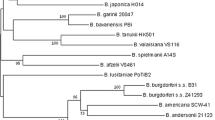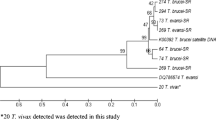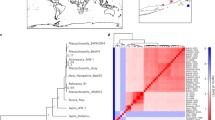Abstract
The internal transcribed spacer (ITS) region was used to study the intraspecies variation of Brugia spp. in cat reservoirs. Blood specimens from seven naturally infected cats were collected from two different geographical brugian-endemic areas in Thailand. The DNAPAR tree of these Brugia spp. was constructed using a maximum likelihood approach based on ITS nucleotide sequences and was compared to those of Brugia malayi, Brugia pahangi, and Dirofilaria immitis that were previously reported in GenBank. The phylogenetic trees inferred from ITS1, ITS2, and complete ITS sequences indicated that B. malayi and B. pahangi were separated into two clades, and subgroups were generated within each clade. The data revealed that ITS2 sequences were less informative than ITS1 for studying intraspecies variation of Brugia spp. Our results are primary data for intraspecies variation of B. malayi and B. pahangi in cat reservoirs. The information could be applicable for studying the molecular epidemiology and the dynamic nature of the parasites.

Similar content being viewed by others
References
Beauchamp KA, Powers DA (1996) Sequence variation of the first internal spacer (ITS-1) of ribosomal DNA in ahermatypic corals from California. Mol Mar Biol Biotechnol 5:357–362
Chansiri K, Tejangkura T, Kwaosak P, Sarataphan N, Phantana S, Sukhumsirichart W (2002) PCR based method for identification of zoonostic Brugia malayi microfilariae in domestic cats. Mol Cell Probes 16:129–135
Chen CA, Chen CP, Fan TY, Yu JK, Hsieh HL (2002) Nucleotide sequences of ribosomal internal transcribed spacers and their utility in distinguishing closely related Perinereis polychaets (Annelida; Polychaeta; Nereididae). Mar Biotechnol (NY) 4:17–29
Chu KH, Li CP, Ho HY (2001) The first internal transcribed spacer (ITS-1) of ribosomal DNA as a molecular marker for phylogenetic and population analyses in crustacea. Mar Biotechnol (NY) 3:355–361
de Rojas M, Mora MD, Ubeda JM, Cutillas C, Navajas M, Guevara DC (2002) Phylogenetic relationships in rhinonyssid mites (Acari: Rhinonyssidae) based on ribosomal DNA sequences: insights for the discrimination of closely related species. Parasitol Res 88:675–681
Hillis DM, Dixon MT (1991) Ribosomal DNA: molecular evolution and phylogenetic inference. Q Rev Biol 66:411–453
Hillis DM, Moritz C, Porter CA, Baker RJ (1991) Evidence for biased gene conversion in concerted evolution of ribosomal DNA. Science 251:308–310
Laing AB, Edeson JF, Wharton RH (1960) Studies on filariasis in Malaya: the vertebrate hosts of Brugia malayi and B. pahangi. Ann Trop Med Parasitol 54:92–99
Lodish H, Berk A, Zipursky S, Matsudaira P, Baltimore D, Darnell J (2001) Molecular cell biology, 4th edn. W.H. Freeman and Company, USA
Lopez-Pinon MJ, Insua A, Mendez J (2002) Identification of four scallop species using PCR and restriction analysis of the ribosomal DNA internal transcribed spacer region. Mar Biotechnol (NY) 4:495–502
Mak JW (1984) Zoonotic filariasis in Malaysia. Malays Vet J 8:9–12
Mak JW, Yen PK, Lim KC, Ramiah N (1980) Zoonotic implications of cats and dogs in filarial transmission in Peninsular Malaysia. Trop Geogr Med 32:259–264
Mak JW, Cheong WH, Yen PK, Lim PK, Chan WC (1982) Studies on the epidemiology of subperiodic Brugia malayi in Malaysia: problems in its control. Acta Trop 39:237–245
Morales-Hojas R, Cheke RA, Post RJ (2007) A preliminary analysis of the population genetics and molecular phylogenetics of Onchocerca volvulus (Nematoda: Filarioidea) using nuclear ribosomal second internal transcribed spacer sequences. Mem Inst Oswaldo Cruz 102:879–882
Nuchprayoon S, Junpee A, Poovorawan Y, Scott AL (2005) Detection and differentiation of filarial parasites by universal primers and polymerase chain reaction-restriction fragment length polymorphism analysis. Am J Trop Med Hyg 73:895–900
Remigio EA, Blair D (1997) Relationships among problematic North American stagnicoline snails (Pulmonata: Lymnaeidae) reinvestigated using nuclear ribosomal DNA internal transcribed spacer sequences. Can J Zool 75:1540–1545
Subbotin SA, Vierstraete A, De Ley P, Rowe J, Waeyenberge L, Moens M, Vanfleteren JR (2001) Phylogenetic relationships within the cyst-forming nematodes (Nematoda, Heteroderidae) based on analysis of sequences from the ITS regions of ribosomal DNA. Mol Phylogenet Evol 21:1–16
Swofford DL (2002) PAUP*. Phylogenetic Analysis Using Parsimony (*and Other Methods), 4.0b10th edn. Sinauer Associates, Sunderland, Massachusetts
Thompson JD, Gibson TJ, Plewniak F, Jeanmougin F, Higgins DG (1997) The CLUSTAL_X windows interface: flexible strategies for multiple sequence alignment aided by quality analysis tools. Nucleic Acids Res 25:4876–4882
Weekers PH, De Jonckheere JF, Dumont HJ (2001) Phylogenetic relationships inferred from ribosomal its sequences and biogeographic patterns in representatives of the genus Calopteryx (Insecta: Odonata) of the West Mediterranean and adjacent West European zone. Mol Phylogenet Evol 20:89–99
Xie H, Bain O, Williams SA (1994a) Molecular phylogenetic studies on Brugia filariae using Hha I repeat sequences. Parasite 1:255–260
Xie H, Bain O, Williams SA (1994b) Molecular phylogenetic studies on filarial parasites based on 5S ribosomal spacer sequences. Parasite 1:141–151
Yokota Y, Kawata T, Iida Y, Kato A, Tanifuji S (1989) Nucleotide sequences of the 5.8S rRNA gene and internal transcribed spacer regions in carrot and broad bean ribosomal DNA. J Mol Evol 29:294–301
Acknowledgments
We would like to thank Mr Sirichai Phantana, Ministry of Public Health, Bangkok, Thailand, for his suggestions regarding sample collection. This project was supported by Srinakharinwirot University, grant number 042/2549.
Author information
Authors and Affiliations
Corresponding author
Additional information
GenBank accession numbers of Brugia malayi and Brugia pahangi complete ITS regions using in this study were EU373601-EU373625 and EU373626- EU373655, respectively.
Rights and permissions
About this article
Cite this article
Areekit, S., Singhaphan, P., Khuchareontaworn, S. et al. Intraspecies variation of Brugia spp. in cat reservoirs using complete ITS sequences. Parasitol Res 104, 1465–1469 (2009). https://doi.org/10.1007/s00436-009-1352-x
Received:
Accepted:
Published:
Issue Date:
DOI: https://doi.org/10.1007/s00436-009-1352-x




